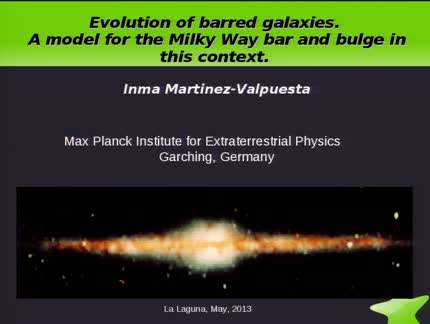Found 57 talks archived in The Galaxy

Abstract
1- The basics
- overview of stellar evolution as a function of mass and metallicity
- from evolutionary tracks to isochrones
- quick overview of chemical changes at the stellar surface

Abstract
1- Fundamental stellar dynamics
- relaxation, collisionless dynamics
- distribution functions, Jeans eqs, etc.

Abstract
1- The use and abuse of N-body codes
- relaxation in spheres and disks, collective enhancement
- code structure, block time steps

Abstract
In the past few years, a series of discoveries have been made of objects which appear to be accreting stellar mass black holes in globular clusters -- both in the Milky Way and in other nearby galaxies. I will discuss why the theoretical work which suggested that such objects would be unlikely to exist, the observations showing they do exist, some of the unusual aspects of some of the individual sources, and the new theoretical framework for producing them.

Abstract
Among the different effects of secular evolution of galaxies we find how bars influence enormously their host galaxies. For many years now, it is known how the evolution of bars will produce different boxy/peanut and X-shape bulges. In this context our Milky Way is an example of a boxy bulge, and we will present a self consistent N-body simulation of a barred galaxy that will be compared with some of the Milky Way available data. We will compare the model in terms of morphology and structure, kinematics and finally metallicity gradients.

Abstract
The classical idea that globular clusters are the prototypes of simple stellar populations has been revolutionized in the last few years. Multiple sequences of stars have been detected in the colour-magnitude diagram of a number of clusters, mostly thanks to high-precision HST photometry, and the correlation with the chemical properties of different generations of stars has been demonstrated. In this talk, we will first present a summary of the observational picture, and we will then introduce the SUMO project (a SUrvey of Multiple pOpulations). This is a long-term project, lead here at the IAC and aimed at detecting and characterizing multiple populations in a large sample of globular clusters. We will review the scope, the observing and reduction strategy, and the first results. So far, data for more than 30 clusters have been secured, using the wide field imagers available at the 2.2m ESO/MPI and INT telescope, thus covering both hemispheres. We will present a new photometric index which turned out to be very effective in detecting multiple RGBs in nearly all the clusters analyzed so far. The connection with the chemical content of the different populations will be also discussed.

Abstract
Abstract: The study of the structure of our Galaxy, particularly its inner disc, has always been hindered by two factors: interstellar extinction dims even the brightest stars at optical wavelengths and the high source density prevents us, as the proverbial trees, to see the big galactic picture.

Abstract
The anomalous microwave emission (AME) is an additional diffuse foreground component, originated by an emission mechanism in the ISM different from the well-known synchrotron, free-free and thermal dust emissions. It was first discovered at the end of the nineties as a correlated signal between microwave CMB maps and infrared maps tracing the dust emission. Ever since several detections have been found in individual clouds in our Galaxy. This emission is an important contaminant for current and future CMB experiments, and therefore its characterization (both in temperature and in polarization) and understanding is mandatory. So far different theoretical models have been proposed to explain the physical mechanism that give rise to this emission. In this talk we will review these models and will present the current observational status of the AME, with particular emphasis on some recent studies that have been performed by our group in the IAC in the Perseus molecular complex and in the Pleiades reflection nebula.

Abstract
Milky Way and most spiral galaxies present some features in the outer part of its disk such as S-warping or U-warping, flaring, lopsidedness, truncation/non-truncation and others, both for the stellar and the gas component. In the present talk, I will review some of the galactic dynamics hypotheses which try to explain these features: either in terms of gravitational interaction, magnetic fields, accretion of intergalactic matter or others. The gravitational interaction may be among the different components of the galaxy or between the spiral galaxy and another companion galaxy. The accretion of intergalactic matter may be either into the halo, with a later gravitational interaction between the misaligned halo and the disc, or directly onto the disc. The phenomena of the outer disc in spiral galaxies might be produced by more than a mechanism. Nonetheless, the hypothesis of accretion of intergalactic matter onto the disc presents several advantages over its competitors, since it explains most of the relevant observed features, whereas other hypotheses only explain them partially.

Abstract
Massive stars dominate the light output of entire galaxies, with luminosities in excess of 105 L⊙. This makes them powerful probes with which to study a range of astrophysical phenomena. In this talk I will review the recent results of our group, in which we have been able to shed new light on the recent star-forming history of our Galaxy, and the nature of supernova progenitors. I will also discuss our latest project, which is to use massive stars as tracers of extra-galactic star-forming histories out to distances of 10 Mpc and beyond.
Upcoming talks
- Quantum Simulators for the Cosmos: From Confining Strings to the Early UniverseDr. Enrique Rico OrtegaThursday December 4, 2025 - 10:30 GMT (GTC)
- Colloquium by Junbo ZhangDr. Junbo ZhangThursday December 11, 2025 - 10:30 GMT (Aula)









